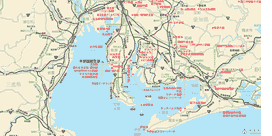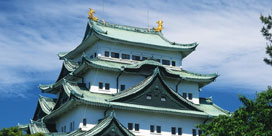EXPO site and Chubu Region
Travelers can enjoy a richly varied trip by seeing the "roof of Japan", the mountainous region of central Honshu, which stretches along mainly Gifu, Nagano, and Toyama Prefectures, the stunning natural scenery of Toyama and Ishikawa Prefectures, which face the Japan Sea, and the history-shrouded shrines and temples of Mie and Wakayama Prefectures.
(A) EXPO → Takayama (around 30 minutes by bus) → Shirakawa-go (90 minutes by bus; overnight stay) -Toyama (2 hours and 30 minutes by bus) → Kanazawa (30 minutes by train) → Wajima (2 hours and 30 minutes by bus; overnight stay) → Kanazawa → Osaka (Total: 2 nights, 3 days)
This course features a tour in Shirakawa-go of traditionally constructed farm houses, which have been designated as a World Heritage Site, nestled within an idyllic natural setting, and the enjoyment of delicious seafoods from the Sea of Japan in Kanazawa and Wajima.
Takayama
Surrounded by the Hida Mountains (a range of mountains that extends across Niigata, Toyama, Nagano, and Gifu Prefectures with a highest peak of over 3,000 meters) and its clear-running rivers, Takayama is known as “Little Kyoto” because of its picturesque natural surroundings and beautiful streets laid out in a grid. The city has many historical places to see, including the Takayama Jinya (Old Government House) and the Hida Kokubunji Temple pagoda.
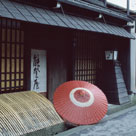
Shirakawa-go
Designated as a World Heritage Site, Shirakawa-go is a historic village of traditional houses in the gassho -style (steeply pitched thatched wooden roofs shaped like a mountain) that sits in the upper reaches of the Sho River Valley at the foot of Mount Hakusan. Visitors can also experience making soba noodles there.
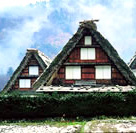
© Shirakawa Village Office
Toyama
Toyama boasts several famous tourist spots such as the Toyama Castle Remains and Kurehayama Park. Visitors can also enjoy fresh seafood taken from the Japan Sea.
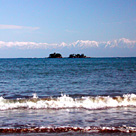
Toyama Bay (Japan Sea)
Wajima
The home of Wajima-nuri (the very durable and beautiful lacquerware specially produced in Wajima), Wajima also has a famous morning market. Several hot spring resorts (onsen ), such as Wajima Onsen, Nebuta Onsen, and Yumoto-Noto-Wajima Onsen, boasting plentiful amounts of hot springs water are located around Wajima City.
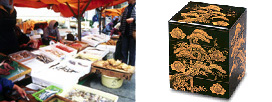
Morning Market and Wajima-nuri
Kanazawa
Counted as one of the three most beautiful gardens in Japan together with Korakuen in Okayama and Kairakuen in Mito, Kenrokuen Garden attracts many tourists because of its distinctive beauty in each season. There are many other worthwhile places to visit in Kanazawa such as Omicho Market (the “kitchen” for the people of Kanazawa) and Nagamachi Bukeyashiki (restored residences of Kaga Clan samurai from the Edo Period).
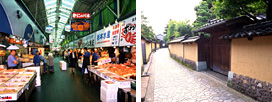
Omicho Market and Nagamachi Bukeyashiki
(B) EXPO → Takayama → Kamikochi (around 90 minutes by bus) → Azumino (around 90 minutes by bus) → Shinano Omachi (around 90 minutes by bus; overnight stay) → Tateyama Alpine Route (around 15 minutes by bus) → Toyama (around 1 hour by bus) (Total: 1 night, 2 days)
This course features a tour of Kamikochi and Azumino, two areas in the midst of the Japan Alps greatly favored by many people for some of the most breathtaking scenery in Japan. Travelers will also delight in the intensely beautiful nature found in Murodo, the highest hot springs resort area in Japan.
Kamikochi
A basin area lying at the foot of the Hodaka Mountains (a range of mountains straddling the border between Gifu and Nagano Prefectures with a highest peak of over 3,000 meters), Kamikochi is one of the most scenic tourist spots in Japan, and the walking path to and from Taisho Pond (a remarkably beautiful pond in which trees stand decayed in the water and the surrounding mountain peaks are reflected on the surface of the pond) is the symbol of Kamikochi. With Kamikochi as a base, visitors can enjoy mountain climbing in the Northern Japan Alps (another name for the Hida Mountains) by many courses.
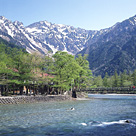
Azumino
Azumino is another very picturesque locale in the Chubu Sangaku (Japan Alps) National Park, where Kamikochi is also located. The views of the Northern Alps and the crystal clear rivers running through the area make Azumino a very refreshing tourist destination.
Shinano Omachi
Visitors can stay at the Kuzu Onsen, the Yunomata Onsen, or the Omachi Onsen and see Nishina Castle, the hot springs geyser in Takase Valley, and other places of interest.
Tateyama Alpine Route
This mountain route threads its way through the Northern Alps and provides magnificent views of mountains towering above 3,000 meters. The route is closed from November to March due to heavy snow. Murodo is the highest hot springs resort area in Japan, and many kinds of alpine flora and snow grouse can be seen there.

Snow grouse
(C) EXPO → Ise Shrine (around 2 hours by train) → Shima (1 hour by bus; overnight stay) → Shingu (2 hours and 30 minutes by train) → Kumano Sanzan (by bus to the shrines) → Nachi Shrine → Nanki Katsuura (30 minutes by bus; overnight stay) → Osaka (3 hours and 30 minutes by train) (Total: 2 nights, 3 days)
This course features appreciation of the mystical sublimity of Ise Shrine and the tranquil natural beauty of Ise and Shima. Travelers will be able to get a glimpse of the ancient spiritual heart of the Japanese people at Kumano Sanzan, where monks undergoing strict religious training are secluded, and other places.
Ise Shrine
With its walks covered with grain-sized pebbles and surrounded by very old cedar trees, Ise Jingu (shrine) has a hushed and mystical atmosphere.
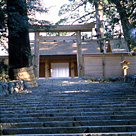
© Jingushi-cho
Shima
Shima is a peninsula famous for its scenic beauty. The waters of its Ago Bay have abundant fishing grounds and are famous for culturing pearls.

Kumano
Kumano Sanzan is the site of the three Grand Kumano Shrines- Hayatama Shrine, Hongu Shrine, and Nachi Shrine- and the shrines have continued to attract numbers of pilgrims for a great many years. Nachi Falls, which is near Nachi Shrine, is considered one of the most beautiful waterfalls in Japan.


